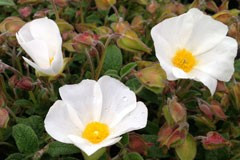
Westringia 'Wynyabie Gem'
One of the better Westringia erimicola cultivars that shapes very well, and provides a lasting dense hedge or screen. Lavender flowers and great bird habitat, avoid winter wet.


This is our cutting grown form which gets to chest high and almost a metre across, like a large lavender. Hundreds of white flowers occur on one plant making this one of our favourite and best selling varieties. The foliage is fine and scallop shaped, allowing plants to shape well into dense mounded form. Pinch out at juvenile stage to develop the best shape. Drought hardy and long lasting.
This is our cutting grown form which gets to chest high and almost a metre across, like a large lavender. Hundreds of white flowers occur on one plant making this one of our favourite and best selling varieties. The foliage is fine and scallop shaped, allowing plants to shape well into dense mounded form. Pinch out at juvenile stage to develop the best shape. Drought hardy and long lasting.
Data sheet
One of the better Westringia erimicola cultivars that shapes very well, and provides a lasting dense hedge or screen. Lavender flowers and great bird habitat, avoid winter wet.
Portugese form of the pink rosemary, more true pink than Majorca pink and less upright, bushier and lower growing.
Male pepper berry plants, usually required to pollinate the female flowers to provide viable berries.
Attractive deciduous specimen shrub, new growth is pink and green which becomes transforms to burgundy and flame red as the season progresses into autumn. Drought and frost hardy, slow growing.
Outstanding deciduous viburnum from the plicatum group, with white flowers in clusters on tiered branches. A versatile shrub that can be combined with perennial underplantings, or planted as individual specimens in lawns or shrubbery.
Lavandula officianalis (syn. angustifolia) . Like 'Hidecote' but a more intense darker purple colour with slightly shorter flower spikes.
Glossy green hedging shrub with sweetly fragrant white flowers in winter. Best in cool conditions.
Deep pink hydrangea, flatter lacecap type like 'Tokyo Delight'; note pink varieties are less affected by soil pH than blue varieties.
Vigorous form with pale flowers and larger leaves than other varieties. Vertical upright growth, suitable for specimen or hedging.
Semi prostrate medium blue form with cascading habit, useful winter flowering ground cover.
Single, white flowered variety, shrubby in form, large flowers and strong growth habit. Clips nicely to form a mound of foliage or low hedge.
A worthwhile silver foliage variety, named after the Welsh castle and gardens. Will grow in low fertility soil, and makes an effective ground cover when combined with cistus, lavender, and rosmary.
Traditional white mop top Hydrangea, flowers do not discolour with pH variation, plants form a good low hedge or border in shady conditions.
Bushy plant with tons of closely packed white single flowers. Reddish buds before the flowers emerge creates a wonderful effect in early summer.
The silvery foliage in combination with the abundant single soft pink flowers creates a lovely effect. Like a wild rose but much easier to look after and without the thorns.
Old fashioned blue mop top hydrangea, needs acid soil to colour up well. Will go towards pink in alkaline soil.

This is our cutting grown form which gets to chest high and almost a metre across, like a large lavender. Hundreds of white flowers occur on one plant making this one of our favourite and best selling varieties. The foliage is fine and scallop shaped, allowing plants to shape well into dense mounded form. Pinch out at juvenile stage to develop the best shape. Drought hardy and long lasting.